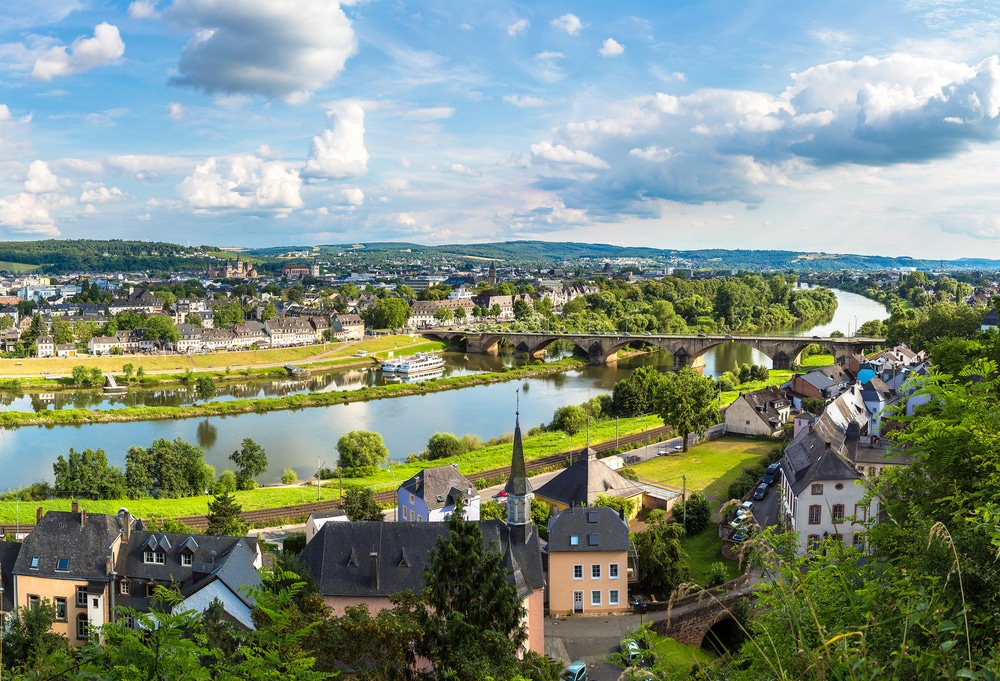Trier – The former Augusta Treverorum is the historical, cultural and economic centre of the Moselle. On the one hand, it is young and dynamic, with an active university, and on the other hand, it is a place where history is more present than almost anywhere else in Germany. The former cosmopolitan city of antiquity has a past that even Rome sometimes envies it. A city of contrasts, shaped by the feudal power of absolutist prince-bishops.
It was in this Catholic stronghold that Karl Marx was born, whose teachings were to become the kind of substitute religion for part of the world. Trier plays the role that is probably its most likeable most convincingly: namely to be the city of wine; somewhat hidden, but very cozy, as quiet corners tend to be.
For the romantic walk through the old town of Trier, you should take at least half a day. Trier has an unusual variety of sights to offer. Some of them are so hidden that they are difficult to find by strangers. Therefore, it is highly recommended to join one of the city tours. You will start in front of the Tourist Information office at Porta Nigra.
PORTA NIGRA / SIMEONSTIFT
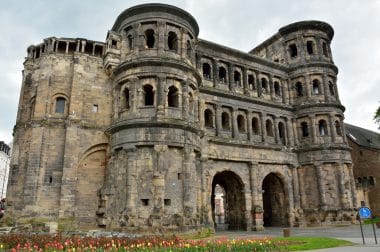
The Roman city gate was built in the last third of the 2nd century from light sandstone blocks against Germanic attacks. Weathering blackened the façade as early as the Middle Ages and gave the building the name Porta Nigra (Black Gate). Converted into a church in the 11th century, it was given a four-winged annex on the west side: the Simeonstift, one of the oldest surviving monastery complexes in Germany. Today it houses the Municipal Museum.
MAIN MARKET TOWN OF TRIER
The market cross (original in the Simeonstift Municipal Museum) was donated in 958 by Archbishop Heinrich as a symbol of the archbishop’s city rule. The Petrusbrunnen (1595) in the south-eastern corner of the square was designed by the Trier sculptor Hans Ruprecht Hoffmann. Through a magnificent Baroque portal on the south side, one reaches the Gangolf Church from the 14th/15th century, which is built all around. Century. The most striking building on the main market square is the “Steipe”, the medieval drinking and festival house (1430 – 1483) of the councillors.
TRIER CATHEDRAL / CHURCH OF OUR LADY
The cathedral dates back to a Roman palace from the 4th century. This makes it probably the oldest basilica in Germany. The most precious relic of the cathedral is the Holy Robe, the legendary robe that Christ is said to have worn until shortly before his crucifixion and is now kept in the Holy Chamber. Sacred art worth seeing is also contained in the treasure chamber in the cathedral.
Connected to the cathedral by the cloister and the so-called paradise is the Church of Our Lady (13th century), one of the first Gothic churches in Germany. Its floor plan resembles the shape of a twelve-petalled rose.
PALAIS KESSELSTATT
The imperial count family built their baroque city residence in the 18th century in the immediate vicinity of the cathedral and the Church of Our Lady on the foundations of a Roman patrician villa.
PALASTAULA / ELECTORAL PALACE
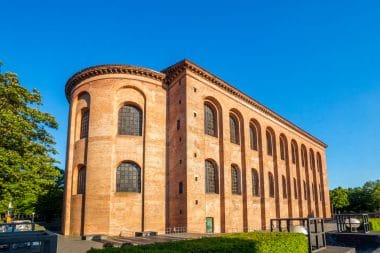
The “Aula Palatina” served Emperor Constantine in the 4th century as a throne room, which was richly decorated with marble slabs and sculptures. In front of the imperial throne, a golden floor mosaic shone in the light, falling through the windows up to seven meters high. Since 1856, the building, which has been freed from the old coloured plaster, has been used by the Protestant church.
Architecturally connected to the Palastaula is the Electoral Palace. From 1757 to 1761, the south wing was added in the Rococo style by Johannes Seiz, one of the students of the Würzburg architectural genius Balthasar Neumann. The figurative decoration of the middle palace façade and the stone sculptures in the palace garden were created by Ferdinand Tietz. Today, the palace is the seat of the Supervisory and Service Directorate.
IMPERIAL BATHS
The spa palace of Emperor Constantine was built around the year 300 and was equipped with technical refinements such as cold, hot water and steam baths. The outer walls of the complex as well as the underground service corridors, heating shafts and ducts still exist.
AMPHITHEATER TRIER
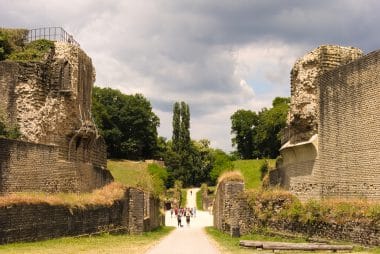
Beyond the old city walls is the amphitheatre, which served as a fortification in the Middle Ages, later as a quarry and vineyard. It was built around 100 AD and could accommodate about 20,000 spectators.
THERMAL BATHS AT THE VIEHMARKT
Trier’s oldest Roman baths from 80 AD were discovered only a few years ago under the cattle market. In 1998, a museum on the bathing industry of antiquity was opened above the ruins.
KARL-MARX-HAUS TRIER
The world-famous philosopher Karl Marx was born in 1818 in a baroque town house at Brückenstraße 10 (now a museum).
ROMAN BRIDGE
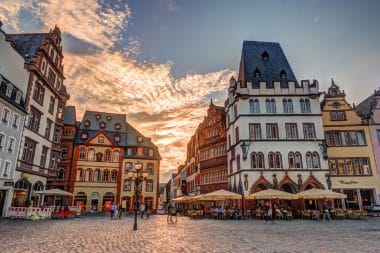
In the 2nd century AD, the Romans built the river crossing to the other bank of the Moselle, five of whose seven pillars are still of ancient origin.
ST. BARBARA’S THERMAL BATHS
This Roman bath complex was built as early as the middle of the 2nd century and was used for several centuries.
ST. MATTHIAS’ CHURCH
The pilgrimage church was built in the 12th century over an early Christian burial ground to house the bones of the apostle Matthias. Between 1496 and 1510, new Gothic vaults were installed and the choir and crypt were lengthened. The porches and tower crowning are Baroque.
RHEINISCHES LANDESMUSEUM TRIER
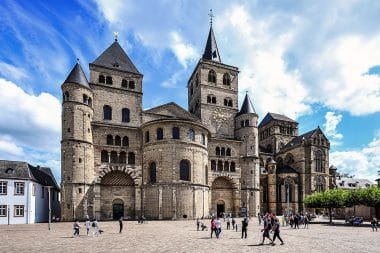
Founded in 1874, the museum displays important collections on prehistory and early history, from the Roman period as well as on the fields of medieval and modern art history. There is no comparable documentation of Roman art in Germany.
MUNICIPAL MUSEUM
In the former cloister from the 11th century, which was built as an extension to the Porta Nigra, the collections of the Municipal Museum are now on display, including painting and sculpture from the Middle Ages to modern times, Dutch and Rhenish painting (mainly 19th century) as well as topography and art history of Trier.
Facts about Trier
Trier, the oldest city in Germany, is rich in history and cultural heritage. Here are some interesting facts about Trier:
- Roman roots: Trier, formerly called “Augusta Treverorum”, was founded in 16 BC and was an important Roman base. The city was part of the Roman province of Gallia Belgica.
- UNESCO World Heritage Site: Trier has an impressive collection of Roman buildings, including the Porta Nigra, the Imperial Baths, the Roman Bridge, and the Basilica of Constantine. These buildings are part of the UNESCO World Heritage Site and attract visitors from all over the world.
- Porta Nigra: The imposing Black Gate, the “Porta Nigra”, is the best-preserved Roman city gate north of the Alps and a landmark of the city. It dates back to the 2nd century AD.
- Imperial Baths: The Imperial Baths are the ruins of a Roman bath complex that was once used by emperors and nobles. They bear witness to the progressive Roman bathing culture.
- Trier Cathedral: St. Peter’s Cathedral in Trier is an impressive Gothic church and a UNESCO World Heritage Site. It houses the Holy Robe, an important religious relic.
- Karl Marx: Trier is also known as the birthplace of Karl Marx, the famous philosopher and social theorist. The Karl Marx House is a museum that offers insights into his life and work.
- Moselle: The town is located on the banks of the Moselle River, which is known for its picturesque vineyards and wine production. The region is famous for its Riesling wine.
- University of Trier: The city is home to the University of Trier, which is one of the oldest universities in Germany and makes an important contribution to education and research.
- Roman Amphitheatre: The Roman Amphitheater of Trier is one of the largest surviving Roman amphitheaters in Europe and offers insights into gladiator fights in Roman times.
- Festivals and events: Trier offers various festivals and events throughout the year, including the Trier Wine Festival, the Trier Old Town Festival and the Antiquities Festival “Bread and Games”, where the Roman era comes back to life.
Trier is a fascinating city that combines the history and culture of Roman times with modern life. The well-preserved Roman ruins, Gothic architecture, and rich wine tradition make Trier a unique and fascinating destination.
Museums in Trier
Trier is a city in Germany with a rich history dating back to Roman times. Here are some of the museums in Trier that showcase the history, art, and culture of the city and its surroundings:
- Rheinisches Landesmuseum Trier: This museum is one of the most important archaeological museums in Germany and offers an impressive collection of artifacts from the Roman, Celtic and medieval periods. The museum is located in the former Premonstratensian monastery of St. Michael.
- Karl Marx House: The birthplace of Karl Marx is now a museum that offers insights into the life and ideas of the famous philosopher and social theorist. Visitors can learn more about Marx’s life and work here.
- Museum am Dom: This museum focuses on sacred art and art objects from Trier Cathedral and other churches in the region. The collection includes paintings, sculptures and liturgical objects.
- Stadtmuseum Simeonstift Trier: The museum is housed in the former Simeonstift monastery and is dedicated to the history of the city of Trier. It houses a wide collection of objects documenting the development of the city from Roman times to the present day.
- Museum of Prehistory and Early History Trier: This museum offers insight into the prehistoric history of the area, including tools, jewelry, and other archaeological finds.
- Museum Karl-Marx-Haus: This museum is dedicated to the history of communism and the workers’ movement and offers exhibitions on Karl Marx as well as the history of socialist movements worldwide.
- Museum am Wasser Trier: The Museum am Wasser is an interactive museum that focuses on the importance of water for the city of Trier. It presents exhibits on water supply, shipping and hygiene in the city.
- Museum of Contemporary Art (Galerie Streitenfeld): This gallery showcases contemporary artworks by regional and international artists and provides a platform for contemporary art exhibitions.
These museums offer a wide range of cultural and historical experiences in Trier. They allow visitors to explore the city’s fascinating history and artistic diversity. Trier is a place that combines history and modernity, and the city’s museums reflect this.


